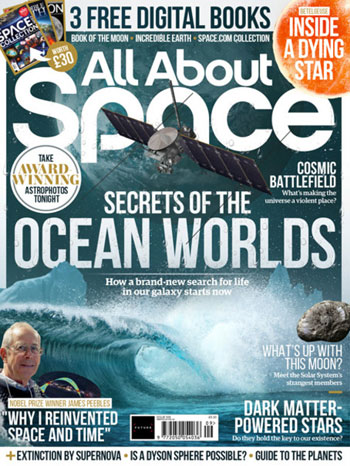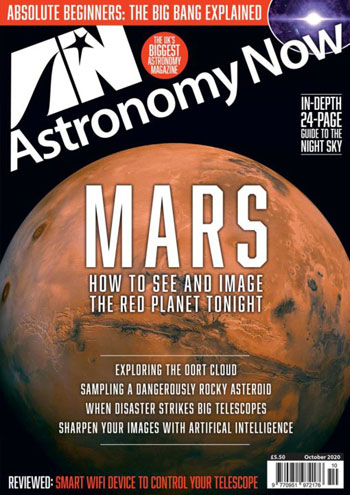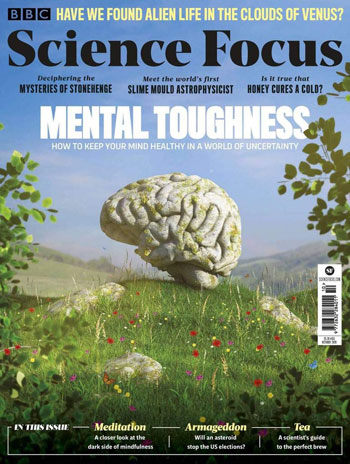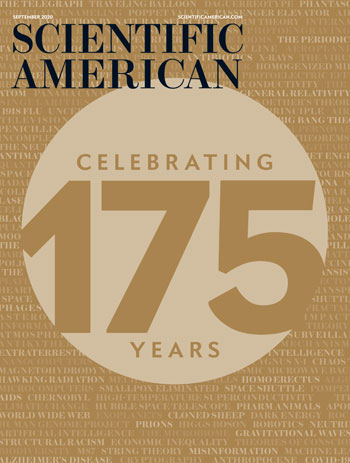
All About Space

What’s it about: ‘All About Space takes you on an awe-inspiring journey through our Solar System and beyond…’ – from the blurb on the publisher’s website.
Vital statistics: Issue 109 (undated but purchased in October 2020): 84 pages of 300mm x 223mm. Matt paper, heavyweight gloss cover, stitched. £5.20 cover price. Publisher’s website states a print circulation of 12,100. Published monthly by Future in Bath.
Cover: Busy. An underlying picture of a big wave to illustrate ‘Secrets of the ocean worlds’, three smaller pictures, no less than ten further coverlines plus the masthead partially obscured by a flying object.
Content: A rather spare contents page belies all the goodies inside. Launch Pad is pictures of and from space plus newsy items. The cover story on Ocean Worlds runs to eight pages and a Q and A interview with a Nobel prize winner also gets the big treatment. Everything – from strange moons and supernova to dark stars and violent universe – is given time and space while a how-to on taking ‘astroimages’ will have you reaching for the camera. All neatly finished off with charts of this month’s planets.
Digital: Have to rummage to find the website www.spaceanswers.com as it’s not overtly promoted in the magazine. Plenty on offer when you get there from news and videos to competitions plus links to Twitter with 36.2k followers and 16k likes on Facebook. Also click through to a YouTube channel that has been dormant for five years.
What they say: “If you’re fed up with being stuck indoors, Venus is currently shining very brightly in the Pleiades star cluster – go and take a look!” – editor Gemma Lavender has the answer to lockdown blues for her Twitter followers.
Verdict: Beautifully put together with astounding photography and helpful graphics, this lively magazine will help readers keep their feet on the ground while exploring all the science that goes with space. Helpful and instructional in equal measure, it keeps on the move from that all-action cover through to the planetary charts at the end.
Astronomy Now

What’s it about: ‘The UK's biggest astronomy magazine’ – telling it how it is on the cover.
Vital statistics: October 2020 issue: 116 pages of 297mm x 210mm. Gloss paper, heavyweight cover, perfect bound. £5.50 cover price. Published monthly by Pole Star Publications Ltd in Tonbridge, Kent.
Cover: Full-bleed close-up picture of Mars with artfully constructed coverlines. Seven other coverlines and full use made of the spine. Masthead on an angle and artwork of ‘AN’ complete with star.
Content: Orderly contents spread divided into Inside, The Night Sky and Equipment before ‘Picture This’, which projects four awe-inspiring photos. Nine pages of news before that cover story on Mars and how to see it at its sweetest. Features on bringing home a piece of asteroid and a mysterious kingdom of comets before the illustrated nightmare that is ‘When telescopes fall down’. Everything you ever wanted to know about the October night sky before timely beginners section, equipment reviews and more dazzling pictures to finish.
Digital: Small pictures and even smaller type give the website an authoritative feel. Tons of content to navigate and links to 114.4k followers on Twitter and a whopping (astronomical?) 576k likes on Facebook. Six pages of equipment reviews is enough to send any armchair stargazer into orbit.
What they say: “I'm not particularly comfortable with self-promotion, but I did want to remind everyone that my book, The Contact Paradox, is still available to buy. Here's one of the nicest reviews that describes it as ‘the best of scientific writing’.” – editor Keith Cooper taking himself out of the comfort zone on Twitter.
Verdict: Somehow manages to straddle the coffee-table voyeurism of mind-bending photography with the scientific detail of a textbook without compromising either. Plenty to either quickly dip into or devour at length and great to see an independent publisher punching above its weight.
BBC Science Focus

What’s it about: ‘The latest science news, future tech, and wonders of the natural world’ – explainer on Twitter page.
Vital statistics: October 2020 issue: 92 pages of 286mm x 216mm. Matt paper, heavyweight gloss cover, perfect bound. £5.20 cover price. ABC circulation of 44,687 (Jan-Dec 2019). Published monthly by Immediate in Bristol.
Cover: Full bleed illustration of a brain to complement the cover story ‘Mental Toughness’. Seven other beautifully crafted coverlines and even four come-ons along the slim spine.
Content: ‘From the Editor’, complete with boffin-like caricature, on page three along with notes on the contributors and a word from our sponsors disguised as ‘On the BBC this month’. Contents spread has small type and lots of white space before ‘Eye opener’ – a jaw-dropping picture of a toxic, radioactive pond in lurid green. Keeps going right to the end with ‘Why do we sleep?’ and ‘How to make the perfect cuppa’.
Digital: Orderly website buried inside a big ad. Today’s top stories, podcasts and science news dominate but it is the ‘Coronavirus latest’ that catches the eye. Also room for some great Q&A - Why do I smell of onions after I’ve been working out? – plus links to Twitter with 23.3k followers and Facebook with 32.5k likes.
What they say: “Primarily, you’ll be responsible for the brand’s most popular section: Q&A… It’ll be your job to dream up an endless mix of topical and mind-blowing questions for our experts to answer, using search trends, social media and reader interactions as your guide,” – ad for a ‘staff writer’ who knows their onions (see above).
Verdict: Prepare to be amazed by the mind-blowing stories throughout plus pictures to enthral (gibbons) and disgust (life of slime) at every turn. This approachable yet authoritative newsstand mag is a science textbook in disguise and would go a long way to plugging that STEM deficit in schools.
How It Works

What’s it about: ‘The magazine that feeds minds!’ – strapline on Welcome page.
Vital statistics: Issue 143 (undated, but purchased in October): 84 pages of 298mm x 230mm. Matt paper, heavyweight gloss cover, stitched. £5.20 cover price. States a ‘distribution’ of 42.1k on the publisher’s website. Published monthly by Future in Bath.
Cover: Big picture of a dinosaur skull eating a paintbrush to promote a fossil hunter story. Ten other coverlines of various shapes and sizes plus six small pictures.
Content: Bypass ‘Welcome’ on page three to find a neat, well-illustrated contents spread divided into History, Science, Technology etc as well as yawnsome ‘Regulars’. Global Eye has quicker reads ‘showcasing the incredible world we live in’ before that cover story on digging for dinosaurs. Historical perspectives on Venice and the London Marathon before a pest special and a jaw-dropping picture of a hippo’s mouth. So much to dip into wrapped up by puzzles and ‘How to make a cloud in a jar’, in case you were wondering.
Digital: Click through to the website promoted on the folio lines to find lots of material clearly displayed behind the same subject dividers as the magazine. Links to Twitter with 18.8k followers and 14.5k likes on Facebook.
What they say: “Ben Biggs is a journalist and former editor of Real Crime magazine, who has a fascination with the minds of serial killers that could be construed as unhealthy to anyone outside the true crime community. He continues to worry his girlfriend with the work he brings home” – editor Ben Biggs moonlighting on Amazon as the author of ‘Serial Killer’.
Verdict: Unencumbered by advertising which is restricted to back and inside covers, this terrier of a publication keeps coming at you with insightful, provocative and yes, fun, content. Is it an encyclopaedia, school textbook or Look and Learn (RIP 1982)? Who knows, how cares. Just unputdownable.
New Scientist

What’s it about: ‘The best place to find out what’s new in science – and why it matters’ – explainer for Twitter followers.
Vital statistics: October 3, 2020 issue: 60 pages of 265mm x 200mm. Matt paper, gloss cover, stitched. £5.95 cover price. Latest (Jan-Dec 2019) ABC of 118,008. Published weekly by New Scientist Ltd in Covent Garden, London.
Cover: Stylish artwork from a German designer featuring planets to illustrate ‘Life beyond earth’ plus eight other delightfully crafted coverlines mostly colour co-ordinated with the bold, yet stylish, masthead.
Content: Contents on first inside facing page sparingly divided into News, Views, Features and The Back Pages. Over the page to non-print delights such as ‘virtual events’ and podcast. Plenty of learned commentary on the ‘C’ word up front, including ‘Should we let the virus rip?’, followed by news and then learned views. A page of letters (remember them?) and that thought-provoking cover story headlined ‘Is anybody out there?’. An interview with Ruby Wax, crossword and a slew of delightful questions answered by readers make sure it finishes with a bang.
Digital: A sophisticated website, unfortunately accompanied by some obtrusive ads (Laughing Cow cheese anyone?) has content galore and an opportunity to sign up for newsletters. Links to Twitter, with 3.7 million followers and 3.5 million likes on Facebook.
What they say: “We're hiring! This time for a world-class journalist who is passionate about all things physics-ee, from dark matter to nuclear fusion” – editor Emily Wilson comes over all inventing of words-ee on Twitter.
Verdict: As one of those publications that everyone has heard of, but may not necessarily have seen, this should be required reading for everyone involved in the magazine industry. Learned yet approachable, authoritative but not stuffy and always right on the money this is a how-to for publishing in the 2020s.
Scientific American

What’s it about: ‘Awesome discoveries. Expert insights. Science that shapes the world’ – explainer on Twitter.
Vital statistics: September 2020 issue: 88 pages of 272mm x 210mm. Gloss paper, heavyweight cover, perfect bound. £6.99 cover price. Media kit advertises a global print circulation of 330,000. Published monthly by Springer Nature in New York.
Cover: Primarily gold in colour ‘Celebrating 175 years’ of the magazine. Behind is a chronological selection of scientific milestones from ‘The Telegraph’ to ‘Misinformation’ via ‘Big Bang Theory’ and ‘Radiation’. Impossible to put down.
Content: Plenty of retrospectives on that 175-year anniversary (demisemiseptcentennial we learn) covering science, technology, medicine, astronomy and evolution. The piece entitled ‘Reckoning with our mistakes’ reviews some of ‘the cringiest articles in the magazine’s history’ so hats off to the self-flagellating editors. Also bang up to date with the ‘Advances’ section of new thinking from George Floyd to wildfires.
Digital: A website every bit as polished and erudite as the magazine, but with updated material too. ‘How to avoid COVID while voting’ manages to combine the two hottest topics in the US. Links to the paid-for treasures in the archive and opportunities to sign up for free newsletters. Follow the links to well-maintained social media pages keeping 3.9 million followers on Twitter happy and gathering 3.2m likes on Facebook.
What they say: “I just did a TV spot about endorsement of Joe Biden and the producer asked me to take down the toy dinosaur on my bookshelf because it looked like it was eating my head and I said EXACTLY” – going behind the scenes with editor Laura Helmuth as the magazine makes its first political endorsement in all those 175 years.
Verdict: Small type, wide columns and lots of long words could make this exacting publication a challenge. But it’s actually a delight, wearing its informed and erudite credentials lightly and enticing the reader with thoughtful graphics and engaging illustrations. It may be American in name, but the approach – and the science – is very much international.
This article was first published in InPublishing magazine. If you would like to be added to the free mailing list, please register here.










